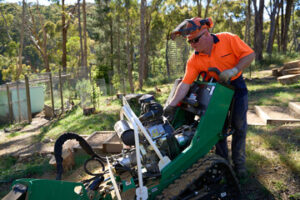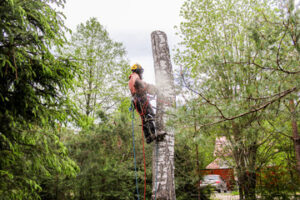Stumps can be unsightly and they also pose tripping and safety hazards. Stump Grinding Phoenix removes these eyesores and allows you to repurpose the area for landscaping.

An experienced stump grinder will be able to grind down the entire root system and break it up into wood chips that can be used as mulch or compost. But it takes careful planning and consideration of nearby structures, such as buildings or sprinkler lines, before starting.
A lingering stump can detract from the beauty of your yard and garden, as well as provide an obstacle for any future landscape plans. Stump grinding is a process that chews away the top of an existing tree stump to eliminate it, leaving a hole that can be filled with wood chips or mulch. The hole can also be leveled for replanting or gardening, providing a clean slate that is free of the tripping hazards and unsightly appearance of a rotting, unattractive tree stump.
Unlike physical removal, which can be expensive and dangerous for those not familiar with the process, stump grinding is relatively inexpensive, quick, and easy to execute. Additionally, it’s less disruptive to the surrounding environment than chemical treatments used in physical removal.
Before the grinding process begins, you should rake up any wood chips that have accumulated around the base of the stump. Any rocks in the area should be removed, as they can interfere with the grinding mechanism. It’s also a good idea to relocate or shield any plants, flowers, or other fragile items near the stump that could get kicked up by the grinder.
The next step is to determine how deep you want the grind to go. A shallow grind will only remove the surface of the stump and a small portion of the roots. However, a deeper grind can be more effective in keeping re-sprouts from occurring. Burke recommends using a stump grinder that can grind at least six inches below ground level for best results.
After the stump is completely gone, you may need to fill the resulting hole with the wood chips or fill in any remaining gaps with topsoil. Some landscaping professionals offer to do this for you as part of the stump grinding service, but it’s an easy enough job that many homeowners choose to handle on their own.
When you’re ready to hire a professional for your stump grinding project, look for a company that offers transparency throughout the process. A trustworthy company will explain their methods in detail, as well as the safety measures they’ll be taking. They should also give you a written estimate for the cost of services.
Safety
Stump grinding is an essential landscaping project that eliminates potential tripping hazards, improves the appearance of the yard and frees up space for other projects. However, like any heavy machinery project, it involves risk, so it is important to take the proper safety precautions.
Before starting to operate the stump grinder, it is necessary to ensure that all safety equipment is in working order. This includes the proper safety goggles, hearing protection to guard against the loud noise of the machine, and durable gloves to keep a firm grip on the equipment. This will help to prevent injuries that can be caused by debris, falling wood chips or sharp cutting edges.
It is also important to examine the site to identify any potential hazards that could stall or jam the equipment. This can include rocks, tripping hazards and electrical wires. It is best to remove these items in advance, if possible, before beginning the grinding process.
Lastly, it is important to make sure that nobody else is near the stump grinder while it is in operation. This is to prevent injuries from being caused by the chipped debris that is ejected from the base of the machine during operation. It is also a good idea to place barriers around the area of the stump grinder so that people or pets are not accidentally harmed.
While it is possible to manually dig out a stump, it is often much easier and safer to use a stump grinder instead. This is especially true for larger or older stumps, which can be extremely difficult to dig out using traditional methods. Stump grinding is also an effective way to prevent pest infestations, as rotting stumps can attract insects and other unwanted guests.
If you are interested in having your stumps ground, contact Eye Tree Surgeons for more information. Our team of experienced arborists is happy to discuss the pros and cons of stump grinding, and we will be able to recommend the best option for your needs. We also offer a variety of other tree services, including pruning, thinning and planting.
Getting Started
The first step in any stump grinding project is to get a clear idea of what is at risk. Burke says the number one way people get injured while doing this type of work is by digging up and hitting underground cables or pipes. Before beginning any such project, he suggests calling the local utility department or using the Diggers Hotline to make sure everything is marked off and safe.
A good stump grinder will have a carbide-tipped steel wheel on the front, which grinds the stump and its surrounding roots into wood chips that can then be removed by the grinder and used elsewhere in the garden. It is also important to consider the depth of the stump and the ground it is in. Stumps that are buried deep in the soil may require more grinding and time to complete than those with their tops above ground level.
Stump grinding is much less expensive and quicker than traditional methods, such as cutting the stump down by hand or using a tractor. It is also more environmentally friendly, as it does not leave a large hole and contaminate the earth around the stump and its root system. In addition, it is possible to avoid the use of toxic chemicals, such as Epsom salts or herbicides, which can contaminate the surrounding area for many years and may attract termites and other pests.
It’s helpful to trim the stump down as close to the ground as possible before starting. It will reduce the overall time of the grinding process and make it easier for the machine to get to work. It’s also a good idea to block off the area to keep people, pets and livestock out of the way while working.
Once the stump is completely ground down, a rake can be used to remove any remaining debris. Then, it’s a good idea to add topsoil and seed the area. It’s best to do this as soon as the weather permits, and before the ground freezes.
Getting rid of old tree stumps and replacing them with new grass or shrubs is a great way to spruce up the yard and give it a fresh, inviting look. While it’s not impossible to do the job yourself, it’s usually a better idea to let a professional handle it for you. They will have the appropriate equipment and can ensure your safety and success.
Cleaning Up
Stump grinding is a great way to remove an old tree stump and prevent unwanted regrowth. Stumps are unsightly, can take up valuable space in your yard, and can cause safety hazards. In addition, they can also be a habitat for pests and insects. To avoid the hassle of dealing with a leftover stump, consider hiring a professional for stump grinding services. The process can be fast, effective, and cost-effective.
During the stump grinding process, a machine cuts the stump down to the ground and chips away the remains of the root system. This allows you to reclaim that space in your yard for a more attractive, functional landscaping feature. The stump grinded remains can be used for a variety of purposes, including mulching flower or veggie beds, making compost, and filling in holes.
Before beginning the grinding process, a worker will clear the area around the stump to ensure there is no debris, toys, tools, or other hazards in the vicinity of the work area. A worker will also put on protective gear, such as goggles, gloves, and chainsaw safety pants. They will also check the work area for safe footing and that there are no power lines nearby.
During the grinding process, the stump and its roots are reduced to a pulpy, pulverized state that can then be easily buried or mulched over. This method of removal is far less invasive than other options, such as burning the stump or using chemical poisons. Chemicals can harm the surrounding environment and often have long-lasting effects, while burning leaves a dangerous mess to deal with and may not eliminate all of the root system.
After the stump grinding is complete, it is important to cover the remaining hole with dirt and mulch to prevent weed growth and further damage to the ground. A layer of mulch can also prevent erosion and protect the soil from the sun’s heat, which could damage it over time.
Another option is to use a herbicide on the remaining root system to kill it and allow the roots to decay naturally into the ground. However, this is not recommended because it can contaminate the surrounding soil and damage nearby vegetation.
